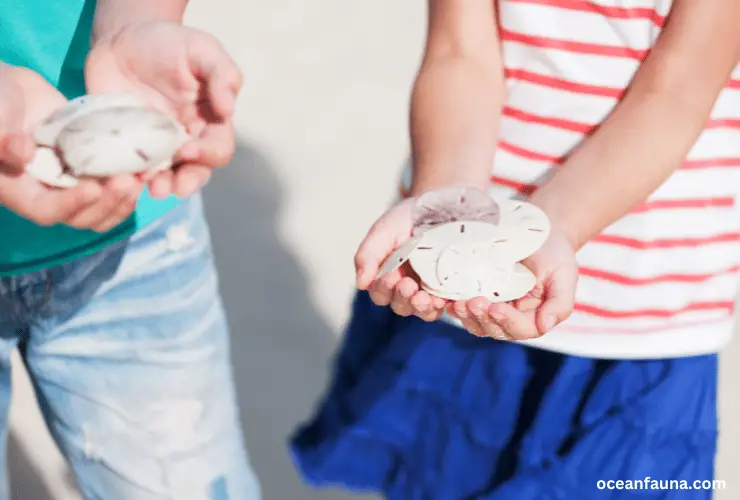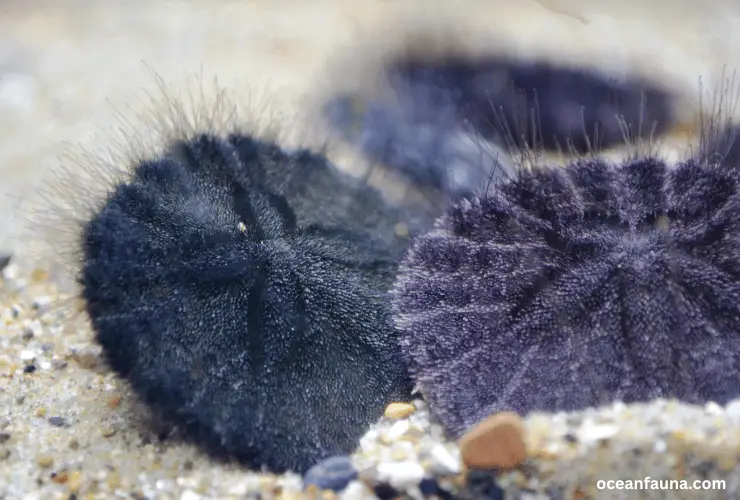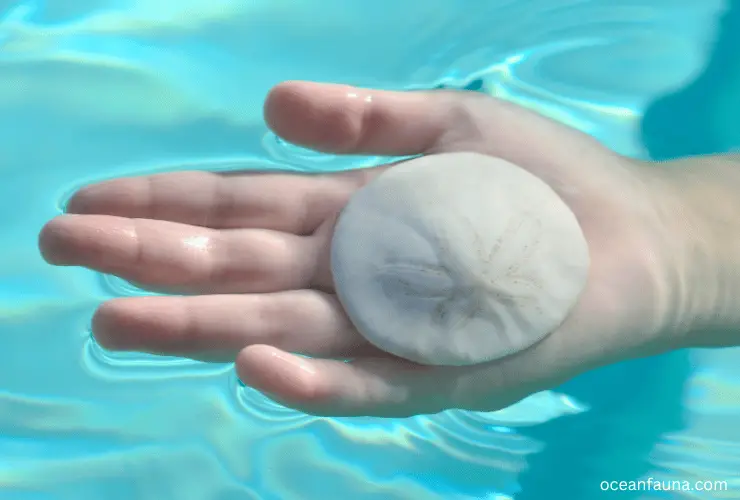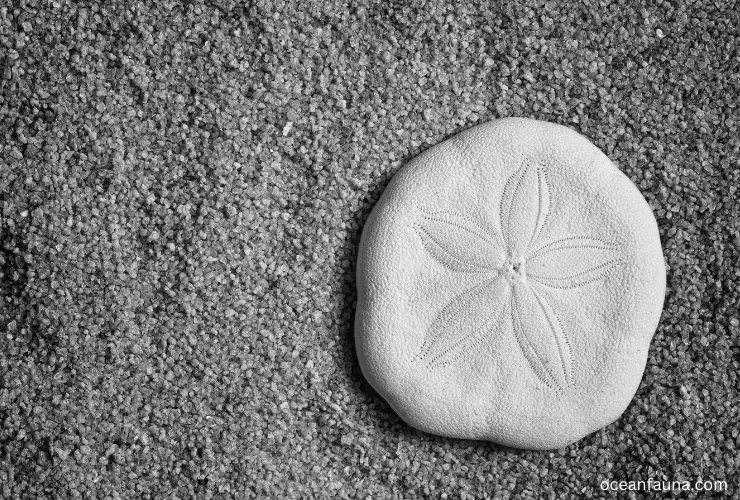The straightforward answer is NO! Humans cannot eat sand dollars. The exoskeleton of sand dollars is made of calcium carbonate, which humans can’t digest. However, animals like octopuses, snails, and fish prey upon sand dollars.
Although we can’t eat sand dollars, these echinoderms are vital in maintaining a healthy ecosystem.
So, let’s buckle down through the article and learn more about sand dollars.
Can Humans Eat Sand Dollars?
No!
Humans can’t eat sand dollars. The reason is that their hard outer shell is made of calcium carbonate.
Calcium carbonate is a hard mineral that is difficult for humans to digest.
Its digestion involves using a lot of stomach acid, thus resulting in various stomach and intestinal issues.
Moreover, if we remove the hard exoskeleton of sand dollar, only a few edible parts are left to eat.
Therefore, eating sand dollars is not an option for humans.
In fact, we cannot eat any other shell marine organisms due to their hard CaCO3 exoskeleton.
Are Sand Dollars Poisonous to Eat?
No!
Sand Dollars are not poisonous to eat.
They aren’t toxic at all.
In fact, they are preyed upon by various marine animals like octopuses, cods, haddocks, seagulls, etc.
They are completely harmless echinoderms.
Are Sand Dollars Harmful to Humans?
No!
Sand Dollars are not harmful to humans, nor are they poisonous.
The only factor that makes them inedible is their hard calcium carbonate shell.
Else, they aren’t poisonous.

Similarly, a live sand dollar is also not harmful.
You can hold a sand dollar for hours in your hand since it doesn’t bite.
However, be careful while picking and touching them.
The reason is that their body is covered with hundreds of thousands of spines. These long spins can puncture your skin.
Is Echinochrome Poisonous?
No.
Sand Dollars secrete a yellow-colored substance called echinochrome.
But it is not poisonous for any living creature, including humans.
Medical studies have shown that echinochrome released by different echinoderms is a Naphthoquinoid pigment.
It is an active substance inhibiting antioxidant and anti-inflammatory abilities.
That is why we use Ech A as an active substance in making cardiac and ophthalmic drugs.
However, echinochrome stains your hand yellow.
How Are Sand Dollars Beneficial for the Ecosystem?
Apart from being a food source for different living organisms, a sand dollar plays various other important roles in the ecosystem.
Some of them are:
Maintains Food Chain
They play a prime role in maintaining the food chain.
They prey upon marine plants. In the same fashion, they act as a source of food for carnivores like fish, snails, and octopuses.
In this way, they help run a successful food web.
Prevents Algal Bloom and Eutrophication
We know that marine plants, if present beyond the limit, lead to algal bloom and eutrophication.
As a result, the water becomes oxygen depleted, thus threatening the life of marine organisms. So, sand dollars prey upon these marine organisms and control their growth.
In this way, these sand dollars help in keeping eutrophication at bay.
Test Act as Fertilizer
Although humans can’t eat sand dollars, they benefit from them in other ways.
The shells of sea urchins and sand dollars are rich in calcium carbonate.
Farmers use them as natural fertilizers to increase the fertility of the land.
Embryological Studies
Sand dollars are extensively used as model organisms for embryological research and experiments.
And here is WHY?
- They can easily be kept in marine aquariums.
- They are not choosy when it comes to food. You can provide them with any marine organism like diatoms, phytoplankton, etc., whatever you find easy.
- They produce and fertilize a large number of eggs.
- They are readily available.
Sand dollars have been experimented with for studying fertilization since the time of Louis Pasteur (early 1920s).
How Does a Sand Dollar Taste?
Since sand dollars can’t be consumed due to their hard shell, little is known about their taste.
However, Dr. Rich Mooi claims to have tried that edible part of sand dollars. According to her, sand dollars aren’t delicious.
Nutritional Content of a Sand Dollar

Sand dollars are counted as a rich source of calcium since their shell is composed of calcium carbonate. However, only a few animals can digest its shell.
Moreover, the echinochrome secreted by sand dollars has iodine in it.
Moving to the nutritional content, one piece of a sand dollar is known to have 180 calories, which includes
Carbohydrates
21g of carbohydrates are present, of which sugars constitute 15 grams.
Protein
Protein is present in minute amounts, i.e., only 1g. It includes 70 mg of sodium, 5 mg of cholesterol, and 0.04 mg of iron.
(Iron comes from the magnetite that sand dollars eat to stand against harsh water currents.)
Fat
A single piece of a sand dollar is known to contain 11g of fats. However, only 6g of the total fats are saturated, the rest being unsaturated and trans fat.
Are All Echinoderms Inedible to Humans?
No!
All echinoderms aren’t inedible to humans. Infact, humans prey upon and eat various echinoderms, which include:
- Starfish
- Sea Urchins
- Sea Cucumber
However, the echinoderms composed chiefly of hard, indigestible shells are not edible to humans.
And after removing the hard test, there is a very small edible potion left to harvest or eat.
Who Else Can Eat Sand Dollars? The Known Predators!
Although humans can’t eat sand dollars, some other vertebrates prey upon sand dollars as their main food. A few of them are:
Sea Gulls
Sea Gulls are counted among the most common Predators of sand dollars. They prey on adult sand dollars, mainly.
They tightly grasp the sand dollars in their mouth and dash them on any hard object.
As a result, the test breaks, and gulls eat all the inside content.
Crabs
Crabs also occasionally prey upon sand dollars.
They pinch the sea biscuits to rip away their bodies and then eat them.
Snails
Surprisingly, snails also eat Sand dollars.
However, they usually prey upon baby sand larvae as they are small in size and easy to chew.
Octopus
The giant octopus also eats sand dollars. And the best part is that they don’t even need to break these sea creatures.
The octopus holds one with its tentacles and swallows the whole in a single gulp.
Fishes
Fishes like cod and sheepshead also eat sand dollars.
However, large fishes like sharks don’t usually prey upon them.
The reason is that sand dollars reside in the low tide sea bed.

On the other hand, sharks are cold-blooded animals.
They can’t live in the challenging temperature of the lower tide.
Apart from these, otters and other fishes feed on sand dollars to obtain food.
However, otters eat sand dollars once in a blue moon.
The reason is that otters inhabit fresh water. On the other hand, sand dollars line in saline (marine) water.
Therefore, otters usually find sand dollars on the shores of the beach.
Can You Keep Sand Dollars as Pets?
Yes!
One can certainly keep sand dollars as a pet. All you need to do is provide them with the right environment to thrive.
Saline Water
Make sure to keep them in a slightly saline environment and not fresh water.
The reason is that they don’t thrive and reproduce in fresh water. Instead, they long for salinity.
Food
Moreover, you need to provide them with lots of algae and other marine plants to feed on.
Keeping sand dollars in an aquarium with other marine organisms is best.
However, while adding fish to the aquarium, be keen enough to avoid adding species that are predators of sand dollars.
FAQs
Q.1 Why do sand dollars have only a few Predators?
Sand dollars have very few predators. The reason is that their exoskeleton contains a protective test.
The test is composed of calcium carbonate CaCO3 plates which are too hard. As a result, most animals can’t digest them.
Q.2 What do sand dollars eat?
Sand dollars eat tiny marine organisms. They primarily feed on marine organisms like algae, kelp, crustaceans, copepods, etc.
They use their spines and tube feet to capture prey.
It uses its spines and tube feet to capture prey.
Q.3 What are Sand dollars used for?
Sand dollars are used to control the food chain by acting as carnivores. They feed on marine plants and control the marine population.
They are used as natural organic fertilizers due to their lime composition.
Moreover, they also serve the purpose of ornaments and jewelry.
Q.4 Can you boil sand dollars?
Yes!
You can boil sand dollars. Boiling sand dollars loosen up the stubborn dirt particles on the shell and help remove them.
Take a saucepan, fill it with water, and add sand dollars in them.
Then bring the water to a boil. Wait for 5 minutes so that the debris loosens up.
Then take out the sand dollars, and here you go.
Conclusion
To wrap it up, we can’t eat sand dollars. It is challenging for the human stomach to digest calcium carbonate shells.
However, there are other predators of sand dollars. These include seagulls, octopuses, cods, etc.
Moreover, they aid in maintaining a healthy marine atmosphere and making organic fertilizers.

